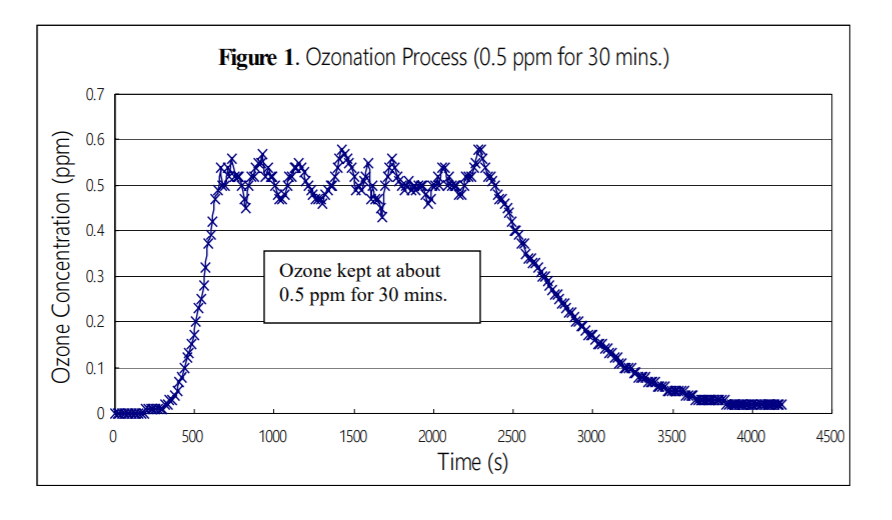In order to test for the effectiveness of ozone in reducing airborne bacteria, a conference room with area about 12㎡ was selected for testing. For safety, the disinfection process was carried out when humans, animals and plants were evacuated.
Depends on the size of the room, an ozone generator with 50mg/hr output (Oshiner Ozone Air) was chosen. The capacity of the chosen ozone generator has the ability to maintain high concentration of ozone (0.5 – 5 ppm) inside. Circulation fan was placed in the room to ensure good distribution of ozone. After closing all the windows and doors, the ozone generator was turned on to begin ozonation process. Different levels of ozone (0.5, 2.5 and 5 ppm) were tested to determine the optimal value for killing as much microorganisms as possible. After turning off the ozone generator, ozone level began to drop as it was undergoing self-decomposition to oxygen.
In general, ozone concentration drops to below 0.02 ppm in a hour after ozonation, therefore we should wait for at least one hour (after turning off the generator) before entering the “ozonated” room.
As shown in the figure, the ozone concentration raise very slowly in the initial period (the first few minutes). The delay in building up the ozone concentration is probably due to the consumption of ozone for oxidizing pollutants (including bacteria and viruses) in the initial period. After oxidizing the major pollutants, ozone concentration inside the room raise rapidly up to the desired level. To ensure entire room disinfection, high level of ozone was maintained for 30 minutes. When ozone generator was off, the ozone concentration dropped gradually as ozone converting back to oxygen.

The total airborne bacteria in the conference room was measured before and after each ozonation. The disinfection efficiency of ozonation at different concentration was tabulated in Table 1.
| Ozone Concentration | 0.5ppm | 2.5ppm | 5ppm |
| Before Ozonation | 592 CFU/m3 | 612 CFU/m3 | 552 CFU/m3 |
| After Ozonation | 169 CFU/m3 | 42 CFU/m3 | 57 CFU/m3 |
| Reduction % | 71.5% | 93.1% | 89.6% |
The results show that ozone is effective in reducing airborne bacteria. At higher ozone level, the sanitizing effect increased. Over 90% of airborne bacteria could be reduced at 2.5 ppm concentration. Further increase of ozone concentration to 5 ppm does not beneficial in bacteria reduction percentage.
Why the result is not 99.9%?
High removal percentage could not be achieved because the room was not 100% sealed. Doors should be opened briefly during each air sampling and air exchange from outside was unavoidable. For safety reason, excessive high concentration ozone should be avoided and the lowest ozone concentration that could kill most of the microorganisms should be selected as optimum. Depends on the contamination level, 0.5 – 2.5 ppm ozone level is adequate for air disinfection.
Conclusion
Experimental data shows that ozone is effective in reducing airborne bacteria of unoccupied room. Over 90% of airborne bacteria could be reduced after ozonation. As viruses are generally more susceptible to ozone than bacteria, it could assume that all viruses are killed if large percentage of airborne bacteria are removed. Ozone is a gas that has good penetration capacity and powerful oxidizing power, thus its disinfection efficiency is superior to UV radiation and HEPA filter. As ozone disinfection is conducted in unoccupied room only and all the residual ozone will be decomposed after the treatment, ozone toxicity to human is therefore not a concern. Given the advantages of strong oxidizing power, good penetration capacity and no harmful residues left after the treatment.
